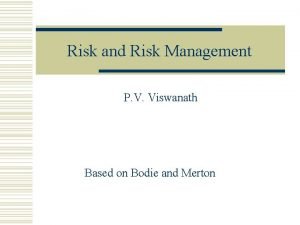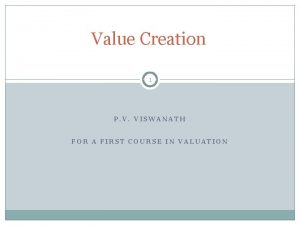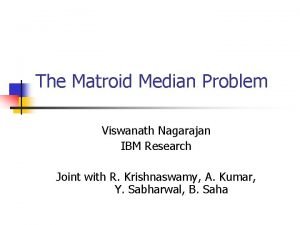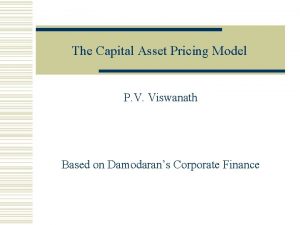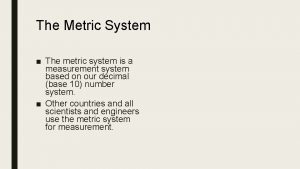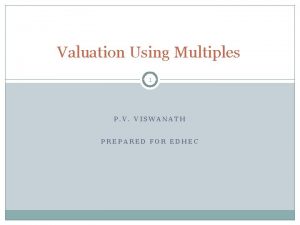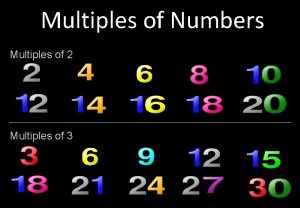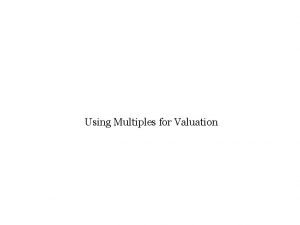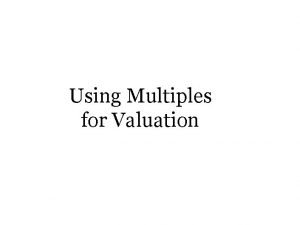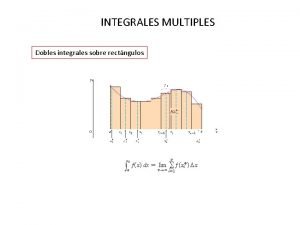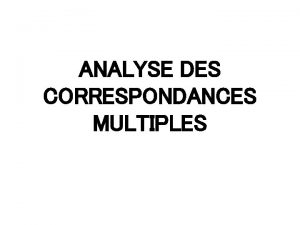Valuation Using Multiples P V Viswanath Valuation of






















- Slides: 22

Valuation Using Multiples P. V. Viswanath Valuation of the Firm

General Foundation Involves utilizing existing valuations of 'comparable' assets to price a given asset by working with a common variable such as earnings, cash flows, book value or revenues. Measures relative values and not intrinsic values. Assumptions tend to be implicit because we take existing valuations of comparables as “correct. ”

Earnings multiples PE ratio (Price per share/Earnings per share) Current PE ratio: based on current earnings per share Forward PE: based on forecasts of next year’s earnings. Price/EBITDA Value of the firm as a multiple of the operating income or the earnings before interest, taxes, depreciation and amortization. Works like a sort of payback ratio

Determinants of PE ratios Start with a simple model P 0 = DPS 1/(k-g), where k is the cost of equity and g is the growth rate of dividends P 0/E 0 = (DPS 1/E 0)/(k-g) = (DPS 0/E 0)(1+g)/(k-g) = (Payout Ratio)(1+g)/(k-g) The higher the growth rate, the higher the PE ratio Keeping the growth rate constant, the higher the payout ratio, the higher the PE ratio Obviously, keeping the same growth rate but raising the payout ratio is only possible if the assets are used more efficiently, i. e if return on assets is higher. This causes a higher valuation.

Book/ Replacement Value Multiples Markets provide asset values through market prices Accountants provide asset values through accounting rules and conventions. The relationship between market value and book value varies from industry to industry and depends on various factors. For example, during a time of inflation, book values will be much higher than market values. The extent of this undervaluation will depend on the firms assets’ exposure to inflation. Thus, if output prices in an industry move less (more) with general inflation, the undervaluation will be less (more) in that industry. Measured as mkt value of firm/ book value of all assets.

Determinants of BV multiples P 0 = DPS 1/(k-g), where k is the cost of equity and g is the growth rate of dividends Divide both sides by BV of assets and noting that DPS 1/BV 0 = (DPS 1/EPS 1)x(EPS 1/BV 0), we get P 0/BV 0 = (DPS 1/EPS 1)x(EPS 1/BV 0)/(k-g), = (Payout ratio)(1+g)(ROE)/(k-g)

Determinants of BV multiples Payout Ratio – the higher the payout ratio, the higher the multiple Growth Rate: the higher the growth rate in earnings, the higher the multiple. ROE: the higher the ROE, the higher the multiple. Cost of equity: the lower the cost of equity, the lower the multiple.

Revenue Multiples Earnings and book values are subject to accounting rules; revenue determinations are less so. Comparisons can be made even if accounting rules for comparables vary. Can be measured as share price/sales per share or Firm value/sales Varies across sectors Depends on profit margins

Determinants of Revenue Ratios P 0 = DPS 1/(k-g), where k is the cost of equity and g is the growth rate of dividends Using similar identities as before, we get P 0/Sales = (Profit Margin)(Payout Ratio)(1+g)/(k-g) The higher the profit margin and the higher the growth rate, the higher the P/Sales ratio. Again, we can conclude a higher payout ratio implies a higher P/Sales ratio only if we assume that the growth rate will not be negatively affected. This will only happen if the ROA is higher.

Marketing Strategy Dupont Analysis tells us that firms have to choose between a high margin/low volume and a low margin/high volume strategy. Clearly, the first strategy will yield a higher Price/Revenue ratio. This can be used to value a brand name. Thus the value of the brand equals [(P/Sales)brand - (P/Sales)nobrand]x. Salesbrand

Profit Margins and P/Sales Higher Profit Margins imply higher Price/Sales ratios, ceteris paribus Hence in using industry Price/Sales ratios, we need to adjust for differences in profit margins. Porter Analysis could be used to predict differences in margins, although this may simply be a difference in marketing strategy, as well.

Using Regression with ratios We have seen that PE ratios depend on growth rates, payout ratios and cost of equity So if it’s possible to find comparables with the same growth rates, payout ratios and cost of equity, the average PE ratio of the comparables could be used to value the target firm. What if the factors are not exactly the same? How about regressing PE ratio on growth rate, payout ratio, ROE and beta? Can we use this relationship to estimate the PE ratio for the target firm? Maybe, but we have to keep in mind that the true underlying relationship may not be linear! Similarly, we could think of regressing P/Sales on profit margins.

PEG Ratio This is the ratio of the PE to the growth rate; if the PE is 15 and the growth rate is 7. 5%, the PEG is 2. The belief is that stocks with a PEG>1 are overvalued and PEG<1 are undervalued. Since this is an equity multiple, the growth rate should be the growth in EPS, not op inc. If the growth rate used is the forecasted growth over the next year, then the PE ratio should be based on current earnings. When comparing across firms, the growth rate estimate for all firms should be over the same time period, e. g. forecasted 5 -year growth rates. Fundamentals don’t support the traditional interpretation of the PEG.

Enterprise Value to EBITDA EV/EBITDA = (MV Equity + MV Debt – Cash)/EBITDA is Earnings before Interest income as well as interest paid, before taxes, depreciation and amortization. This is a firm-level multiple, which is why we add back interest paid Interest income is subtracted out because the idea is to look at operating income – interest income may not be part of the firm’s core operations.

Enterprise Value to EBITDA Once we exclude interest income, we also exclude cash and cash equivalents from the numerator. Once the enterprise value is computed, we add back cash and cash equivalents to get a value of the entire firm. If a firm has minority holdings, the ratio may be overstated because income from these holdings is not included in the operating income of the firm, while the value of the equity interest is included in the numerator.

Determinants of EV/EBITDA FCFF = EBIT(1 -t) – (Capex - DA +DNoncash WC) = (EBITDA-DA)(1 -t) – Reinvestment = EBITDA(1 -t) – Reinvestment = Capex - DA +DNoncash WC Since V 0 = FCFF 1/(WACC–g), we get:

Factors in high EV/EBITDA A low marginal tax rate: A smaller tax bite Higher EBIT as a proportion of EBITDA: the EBIT portion of EBITDA obviously has greater value. Lower reinvestment needs as a percentage of EBITDA: implies higher ROA Lower cost of capital: lower discount rate Higher expected growth: higher future FCFF

When to use an EBITDA Multiple Used for firms in industries with high depreciation, where EBITDA is a better measure of operating cashflow than EBIT or Net Income. When the firms being compared have different depreciation methods, using an EBITDA multiple keeps them comparable as opposed to an income multiple.

ROA and ROE In general, firm value multiples depend positively on ROA, while stock value multiples depend positively on ROE. The factors affecting a firm’s ability to have a higher ROA/ROE can be seen from Porter’s Five Forces model: Barriers to entry Weak Buyers Weak Sellers Low Threat of substitutes Market power relative to competitors

ROE, ROA and ratios A firm with a high (low) ROA/ROE and a low Price/Book ratio is likely to be undervalued (overvalued). Thus, if we regress P/B on ROE, firms with very high residuals may be overvalued, while those with very negative residuals are likely to be undervalued. This could be used as a screening device. Of course, the ROE used in this analysis should be forward looking, else the results may be misleading.

P/B as a proxy for risk We are implicitly keeping everything else constant; thus it’s better to do this analysis on firms in the same industry. Else we might be mistaking riskier firms for undervalued firms. Fama and French find evidence that a high P/B ratio is a proxy for risk. They find that high P/B stocks earn consistently more than low P/B stocks.

Sector specific multiples Sometimes there are clear drivers in a given industry. In this case, specific multiples may be used in that industry. For example, in subscription-based firms, value per subscriber could be used. For retailers, value per customer may be used. For internet portals, value per site visitor could be used. Airlines? Wireless cos? Home improvement firms?
 Lakshmi
Lakshmi Pv viswanath
Pv viswanath Pv viswanath
Pv viswanath Introduction of finance
Introduction of finance Viswanath nagarajan
Viswanath nagarajan Capm damodaran
Capm damodaran Valuation of fixed income securities or valuation of bonds
Valuation of fixed income securities or valuation of bonds Projection des vues
Projection des vues Factors and multiples jeopardy
Factors and multiples jeopardy Damodaran multiples europe
Damodaran multiples europe Common factors of 20 and 24
Common factors of 20 and 24 Lcm of 12 and 18
Lcm of 12 and 18 Démonstration petit théorème de fermat
Démonstration petit théorème de fermat Intelligences multiples
Intelligences multiples Dua cast
Dua cast Prefix of metric system
Prefix of metric system Even numbers defination
Even numbers defination Factor and multiple
Factor and multiple Factors of 72
Factors of 72 Metastasis hepaticas multiples
Metastasis hepaticas multiples Multiples of 2 chart
Multiples of 2 chart Multiples and factors class 4
Multiples and factors class 4 What is the lcm of 8 and 2
What is the lcm of 8 and 2

